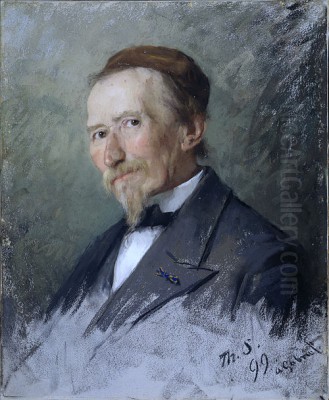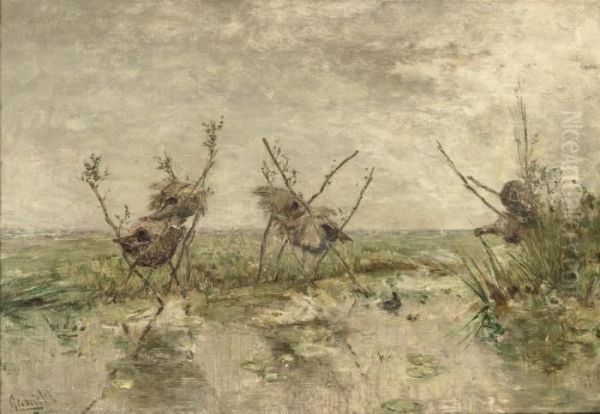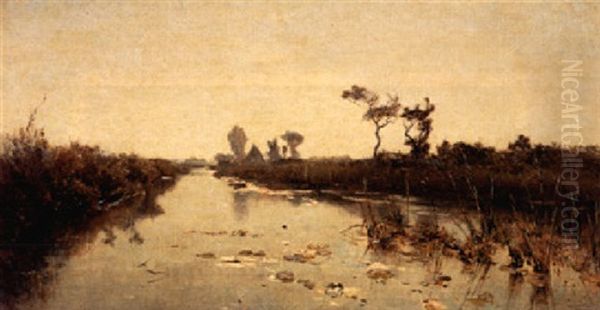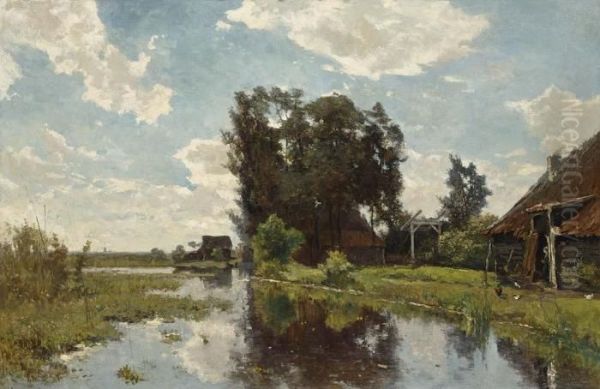
Paul Joseph Constantin Gabriel stands as a significant figure in 19th-century Dutch art. Born on July 5, 1828, in Amsterdam, and passing away on August 23, 1903, in Laren, Gabriel was a painter, draughtsman, watercolourist, and etcher primarily associated with the Hague School. Yet, his artistic journey and distinct style set him apart, offering a brighter, more colourful perspective on the Dutch landscape compared to many of his contemporaries. His work captures the essence of the Netherlands' natural beauty, from its expansive polders to its iconic windmills, rendered with a sensitivity to light and atmosphere that remains captivating.
Early Life and Artistic Foundations
Gabriel's artistic inclinations were nurtured from a young age. His father, Paul Joseph Gabriel, was a sculptor and painter, providing an immediate connection to the art world. It was, however, his mother, also an artist, who gave him his initial drawing lessons. This familial immersion in art laid the groundwork for his future pursuits. Seeking formal training, Gabriel attended evening classes at the prestigious State Academy of Fine Arts (Rijksakademie van beeldende kunsten) in Amsterdam between 1840 and 1843. During this period, he studied under Louis Zocher, further honing his foundational skills.
Seeking to deepen his understanding of landscape painting, Gabriel made a pivotal move. He travelled to the German town of Kleve, situated near the Dutch border. There, he entered the private academy of Barend Cornelis Koekkoek, one of the most celebrated Dutch Romantic landscape painters of the time. Koekkoek's influence emphasized meticulous detail, dramatic compositions, and an idealized vision of nature, often drawing inspiration from the Old Masters. This training provided Gabriel with technical proficiency and a grounding in the established landscape traditions.
Oosterbeek: The Dutch Barbizon

In 1853, Gabriel relocated to Oosterbeek, a village near Arnhem that was rapidly becoming a magnet for landscape painters. Often referred to as the "Dutch Barbizon," Oosterbeek attracted artists seeking direct inspiration from nature, much like the French painters who gathered in the Forest of Fontainebleau. Here, Gabriel associated with the circle around Johannes Warnerus Bilders, a key figure in the Oosterbeek artists' colony. This environment fostered a spirit of camaraderie and encouraged painting en plein air (outdoors), allowing artists to capture the immediate effects of light and atmosphere.
It was in Oosterbeek that Gabriel formed important friendships and artistic connections. He met and worked alongside Anton Mauve, another future luminary of the Hague School. This period was crucial for Gabriel's development, marking a shift away from the more rigid Romanticism of Koekkoek towards a more direct, naturalistic engagement with the landscape. The shared experiences and artistic dialogues in Oosterbeek undoubtedly shaped the direction of his art, emphasizing observation and a more personal interpretation of the Dutch countryside. The influence of the French Barbizon School, with artists like Jean-Baptiste-Camille Corot and Théodore Rousseau championing realism and atmospheric effects, resonated strongly within the Oosterbeek circle.
The Hague School Context
Paul Joseph Constantin Gabriel is firmly placed within the Hague School (Haagse School), a movement that dominated Dutch painting in the latter half of the 19th century. Flourishing roughly between 1860 and 1890, the Hague School artists sought to portray the Dutch landscape and rural life with realism and a focus on atmosphere. They rejected the idealized scenes of Romanticism, favouring instead the everyday beauty of the Netherlands – its flat landscapes, grey skies, canals, fishing villages, and working people.
Key figures of the Hague School included Jozef Israëls, known for his poignant depictions of fisherfolk; the Maris brothers – Jacob, Willem, and Matthijs – each contributing unique perspectives on landscapes, cityscapes, and genre scenes; Hendrik Willem Mesdag, famous for his seascapes, particularly the Panorama Mesdag; Anton Mauve, celebrated for his pastoral scenes with sheep; Willem Roelofs, an early pioneer who brought Barbizon influences back to the Netherlands; and Johannes Bosboom, renowned for his church interiors. The prevailing mood was often one of moody introspection, captured through a tonal palette dominated by greys, browns, and muted greens – earning it the nickname the "Grey School."
Gabriel's Distinctive Style: Colour and Light

While undeniably part of the Hague School, Gabriel carved out a unique niche within the movement. A defining characteristic of his work is its relatively bright and colourful palette, which often contrasted with the more subdued, tonal approach favoured by many of his peers. He possessed a remarkable ability to capture the clarity of Dutch light, the reflections in water, and the vibrant greens of the summer polders. Gabriel himself is quoted as saying, "Our country is not grey, even when the weather is grey." This statement encapsulates his commitment to finding colour and light even in the typically overcast Dutch climate.
His landscapes often depict the wide, flat expanses of the Netherlands, punctuated by windmills, farmhouses, canals, and cattle. He was particularly adept at rendering water, capturing its reflective qualities and the interplay of light on its surface. Unlike the often melancholic mood found in the works of Israëls or Mauve, Gabriel's paintings frequently possess a sense of clarity, openness, and even cheerfulness. He celebrated the working landscape but focused more on its visual harmony and atmospheric conditions than on the hardships of rural labour.
Representative Works
Several paintings exemplify Gabriel's artistic vision. A Windmill on a Polder Waterway (circa 1889), housed in the Rijksmuseum, is perhaps one of his most famous works. It showcases his mastery of light and reflection. The iconic Dutch windmill stands silhouetted against a bright sky, its form perfectly mirrored in the still water of the canal below. The colours are clear and luminous, capturing a specific moment with striking realism yet imbued with a picturesque quality. This work clearly demonstrates his departure from the "grey" tendencies of some Hague School painters.
Another notable work, sometimes titled In the Month of July, similarly features a windmill in a lush, green summer landscape under a bright, cloud-filled sky, again emphasizing vibrant colour and light. Duck Nests (Eendennesten) reveals his attention to the intimate details of nature within the broader landscape. Landscape with two Trees (1860-1867) represents his earlier engagement with landscape motifs, while Landscape near Overschie shows his continued exploration of specific Dutch locales. Landscape with a train (1887) incorporates a modern element into the rural scene, reflecting the changing times. His work often titled De eerste baars (often translated less accurately as Early Morning Seagulls, but meaning The First Perch [fish]), highlights his interest in specific moments and activities within the landscape, likely depicting early morning fishing.
Mastery Across Mediums

Gabriel was not confined to oil painting; he was also a highly skilled watercolourist and etcher. His watercolours possess a fluidity and transparency that perfectly suited his interest in light and atmosphere. This medium allowed for rapid execution, ideal for capturing fleeting effects observed outdoors. His watercolours often served as studies for larger oil paintings but are also accomplished works in their own right, admired for their freshness and spontaneity.
His work as an etcher further demonstrates his versatility. Etching, with its reliance on line and tone, allowed him to explore different textural possibilities and compositional structures. Like his paintings and watercolours, his etchings primarily focused on Dutch landscapes, translating his observations of nature into the graphic medium. This proficiency across different techniques enriched his artistic practice, allowing him to express his vision in multiple ways.
Life and Work: Brussels and Scheveningen
Gabriel's career involved periods spent outside the immediate centres of Dutch art. From 1860 to 1884, he lived and worked in Brussels, Belgium. This extended stay abroad likely exposed him to different artistic currents and landscapes, although his primary focus remained the Dutch scenery, which he frequently revisited during summers. The reasons for his move to Brussels are not entirely clear, but it was a significant period of production for him. His connections with the Belgian art scene, including artists like Louis Artan and Félicien Rops, may have offered different perspectives, although his core style remained rooted in Dutch naturalism.
In 1884, Gabriel returned to the Netherlands, settling in Scheveningen, the coastal district of The Hague. This brought him back into the heartland of the Hague School during its mature phase. Living by the sea potentially offered new subjects, although his most iconic works remain focused on the inland polder landscapes. His final years were spent in Laren, another artists' colony, where he passed away in 1903. Throughout these relocations, his dedication to capturing the specific light and atmosphere of the Dutch landscape remained constant.
Collaborations and Artistic Relationships
The art world of the 19th century was often collaborative, and Gabriel participated in this aspect of artistic life. His friendship and working relationship with Anton Mauve, established during their time in Oosterbeek, was significant. They shared an interest in painting directly from nature and likely influenced each other's development. While specific jointly created works are not commonly cited, their shared time painting outdoors represents a form of collaborative engagement with the landscape.
A more documented collaboration involved the younger painter Willem Bastiaan Tholen. Tholen, who represented a transition towards a later phase of Dutch Impressionism, was influenced by Gabriel's approach to light and colour. Tholen painted a well-known portrait titled The Painter Gabriël Working in a Boat, capturing Gabriel in the act of painting en plein air. This image not only documents their relationship but also visually represents Gabriel's commitment to direct observation from nature. Their association highlights Gabriel's role not just as a peer to the core Hague School figures but also as an influence on the next generation.
Legacy and Influence
Paul Joseph Constantin Gabriel occupies a respected and distinct position within Dutch art history. As a member of the Hague School, he contributed significantly to the movement's overall depiction of the Netherlands. However, his insistence on a brighter, more colourful representation of the landscape set him apart and perhaps anticipated later developments towards Impressionism in the Netherlands, as seen in the work of artists like George Hendrik Breitner or Isaac Israëls, though his style remained fundamentally rooted in realism.
His work challenged the notion that the Dutch landscape was inherently grey and moody, revealing its capacity for light, colour, and vibrancy. He demonstrated that realism could encompass clarity and brightness as much as it could tonal subtlety and atmospheric haze. His paintings, watercolours, and etchings are held in major collections, including the Rijksmuseum in Amsterdam, the Kröller-Müller Museum, the Kunstmuseum Den Haag, and Museum Boijmans Van Beuningen, ensuring his contribution remains visible and appreciated.
Gabriel's legacy lies in his skillful and sensitive portrayal of the Dutch landscape, rendered with a unique emphasis on light and colour that distinguished him within the celebrated Hague School. He remains a testament to the diversity within artistic movements and the power of individual vision in interpreting the familiar world. His dedication to capturing the specific beauty of his homeland continues to resonate with viewers today.
Conclusion
Paul Joseph Constantin Gabriel was more than just a member of the Hague School; he was one of its most distinctive voices. Bridging the gap between the meticulousness learned from Romantic painters like Koekkoek and the atmospheric realism championed by his Hague School contemporaries like Mauve and Jacob Maris, he forged a path characterized by luminous colour and a clear-eyed appreciation for the Dutch landscape. His works, from the iconic windmills reflected in still waters to the intimate details of the polder, offer a vision of the Netherlands that is both realistic and radiant. His contribution enriches our understanding of 19th-century Dutch art, showcasing the beauty found in light, colour, and the enduring landscapes of his homeland.